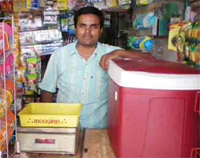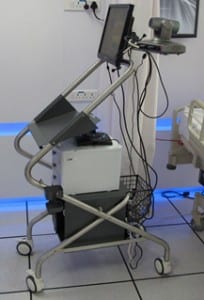By: Peter Hesseldahl
Studying how companies in the emerging markets innovate can offer Western engineers and designers important inspiration, and challenge them to develop products that are much cheaper. Such “frugal solutions” will become increasingly important in order to stay relevant in the stagnant markets of the West – as well as for the upcoming global middle class of developing countries. This study focuses on the “jugaad” innovation of India.
Jugaad is an Indian phrase used to describe the kind of ingenuity that enables Indians to manage the large and small challenges of everyday life. The essence of Jugaad is to improvise, and to quickly and cheaply cobble a solution together from the materials you have at hand.
In recent years, Jugaad has gained attention among companies in the western world because products like Tata’s Nano car and GE’s MAC scanner for hospitals, have shown that the Indian approach to innovation can lead to solutions for the mass market at extremely low prices.
Jugaad innovation springs directly from the very concrete restrictions that characterize everyday life in India: Average income pr. person in India is less than a tenth of the Northern European average, and on a practical level, one must contend with an often miserable and unpredictable infrastructure, whether it’s bad and congested roads or intermittent supplies of electricity and water.
Although one can find lots of fascinating and imaginative solutions to very specific and local problems in India, the relevance to companies in the developed world comes from identifying those parts of the Indian approach to innovation, which can be used to develop solutions that have commercial potential on a large scale.
In 2012, The Universe Foundation, as part of a larger project on “frugal” solutions, has conducted extensive research on the Jugaad concept, including visits and discussions with a number of the leading Indian companies that deliberately aim to create low-cost solutions.
The assumption has been that there are elements in the Indian methods and attitudes, which are so general, they can be transferred and used by Western companies as an inspiration and challenge to the usual way of thinking about business development.
The conclusion is that jugaad innovation certainly has relevance in the West – not least because there are many indications that the demand for products and solutions at much lower prices will increase. Financially strapped consumers in developed, Western markets will demand basic solutions at a low price. Low prices will also be a prerequisite for Western companies in order to address the rapidly growing middle class in emerging markets.
Characteristics and methods that are most relevant for Western companies to consider
Hard prioritization of features
Engineers and designers must have a proper understanding and feel for the end users’ needs and ability to pay. Developers must prioritize extremely hard to remove all unnecessary functions, and in many cases designers must develop completely new ways to achieve a given functionality that are simpler and cheaper.
As one designer of medical devices at GE in Bangalore puts it: “Basically, I only use three buttons on the remote control for my TV. In the same way, we try to understand what the three most necessary buttons on the devices we develop are”.
GE’s Lullaby baby warmer
 While GE often develops products from scratch, in some cases the approach is to de-feature existing solutions by removing some functions or components, based on an understanding of what are essential needs of the end-users. As Ravi Kaushik from GE department for maternal healthcare at GE in Bangalore puts it, one should preferably be able to offer 50% of the functionality at 20% of the price. One example is GE’s Lullaby baby warmer for premature babies. In the premium model made in USA, the bed can be tilted by means of an electric motor. On the less expensive Indian model, the motor control was replaced with a crank and handle. In an upcoming, even lower priced version, the crank handle might be removed. Instead, they might now simply put a wedge under the mattress.
While GE often develops products from scratch, in some cases the approach is to de-feature existing solutions by removing some functions or components, based on an understanding of what are essential needs of the end-users. As Ravi Kaushik from GE department for maternal healthcare at GE in Bangalore puts it, one should preferably be able to offer 50% of the functionality at 20% of the price. One example is GE’s Lullaby baby warmer for premature babies. In the premium model made in USA, the bed can be tilted by means of an electric motor. On the less expensive Indian model, the motor control was replaced with a crank and handle. In an upcoming, even lower priced version, the crank handle might be removed. Instead, they might now simply put a wedge under the mattress.
You’ve got to jump in the fishbowl
It is crucial to know the market well, in order to distinguish exactly what end-users need to have, rather than what is merely nice for them to have. “You’ve got to jump in the fishbowl, if you want to understand fish” says G. Sunderraman, head of development at the Indian industrial conglomerate Godrej.
The Chotokool refrigerator
 During the development of Chotokool, a very cheap and compact refrigerator designed for families and small retailers in the country, Godrej’s designers went to visit potential customers in villages many times to understand their needs. Later in the development process, the designers returned with prototypes and collected more responses and ideas from end users. In total, the team spent 50 days with users in villages.
During the development of Chotokool, a very cheap and compact refrigerator designed for families and small retailers in the country, Godrej’s designers went to visit potential customers in villages many times to understand their needs. Later in the development process, the designers returned with prototypes and collected more responses and ideas from end users. In total, the team spent 50 days with users in villages.
The result – called Chotokool – was a refrigerator with a 43liter volume. Cooling is done using so-called “Peltier” technology. It draws only between 40 and 60 watts.Chotokool can operate from batteries or solar cells. The box is made of plastic and the entire unit is assembled from a total of 20 parts. The Chotokool is opened from above, so the cold air stays down in the box. The price is Rs. 3,400 – approx. US$ 65.
High volume
One strategy for low-cost solutions is to base the product on proven technology and to build it from components that are already produced in large numbers.
Generally, it is crucial to achieve a high volume. “We reach far more customers by lowering prices, but we earn less per customer”, says a director of a hospital, which has organized its treatments inspired by Henry Ford and MacDonald’s assembly line production. With higher volume and more customers the cost of development, equipment, personnel and buildings can be spread.
The courage to think differently
Perhaps the biggest challenge for Western engineers is to accept that the price must to be radically lowered in order to reach the target group. Therefore designers must restrain their professional ambitions of advanced technology, smooth performance and optimum convenience for users.
Designers must, so to speak, develop from the bottom up, by starting to improve the solutions that the users in the lower part of the market currently have available – rather than trying to make lesser version of what the company is currently offering in the premium end of the market.
Simple, but driven by a different mindset
Many Western companies have certainly discovered the low cost challenge, and they are scrambling to develop product lines that can give them access to the middle class in India and other emerging markets. These foreign companies all develop the new products in India, and with teams, which are staffed by local engineers and designers. In many cases, local adaptations are based on very simple ideas – but, mind you, ideas that western developers never would have come up with, because they do not fully understand the context, that a product is used in.
Philips Healthcare’s high-definition video camera
 Philips Healthcare has developed a high-definition video camera, which can be used by clinicians, so they can see patients at a distance. For the version sold in India, the Indian engineers put the unit on wheels so it could easily be rolled around to different beds. The Western designers had imagined that there would be a camera mounted at each bed – which fits well in western hospitals with single-or two-bed rooms, rather than Indian hospital rooms with 10-20 patients.Similarly, Philips lowered the price of a hospital bed by removing the electric height-adjustment feature, which makes entering the bed easier. Instead, for the Indian version, the bed is fitted with a footboard. This had the side effect that it is faster to use, because there is no waiting for the bed to be electrically moved up and down.
Philips Healthcare has developed a high-definition video camera, which can be used by clinicians, so they can see patients at a distance. For the version sold in India, the Indian engineers put the unit on wheels so it could easily be rolled around to different beds. The Western designers had imagined that there would be a camera mounted at each bed – which fits well in western hospitals with single-or two-bed rooms, rather than Indian hospital rooms with 10-20 patients.Similarly, Philips lowered the price of a hospital bed by removing the electric height-adjustment feature, which makes entering the bed easier. Instead, for the Indian version, the bed is fitted with a footboard. This had the side effect that it is faster to use, because there is no waiting for the bed to be electrically moved up and down.
Frugal innovation is an important tool for addressing future growth markets
Frugality is one of the characteristics that are important in the markets of future. It will be one of the key challenges for Western companies to learn how to compete in the low part of the market – both because Western producers will face competition from low-cost producers in the domestic market, and because low prices and frugal solutions are essential in order to address the rapidly growing middle class in emerging markets.
Already today some areas of consumption in the developed markets – such as healthcare – are experiencing that budgets are increasingly squeezed. There are many indications that consumers in the developed countries will become very conscious of choosing solutions that focus on real needs and deliver at low prices
By studying conditions in countries such as India, and by observing the innovation strategies that companies there are using, Western companies can get an early indication of the approaches, methods and terms, which they can use to develop frugal solutions.
Looking at the methods used in India suggests that frugal innovation would imply a fundamental challenge to the current thinking, organizing and business models of a typical Western company.
Developments of frugal solutions require you to re-think the whole chain of business: from market research, design and development, through to marketing and distribution, if you really want to compete in the low price segment.
You can read more about the Universe Foundation’s project on “frugal solutions” at: www.frugalsolutions.org
Series of Articles
Read the series of articles at
1. Learning from Asian Innovation
2. Jugaad Innovation
3. The New Normal: From Product to Platforms and Processes
4. Global Platforms for Co-creating Hyper-Local Solutions
About the author
 Peter Hesseldahl is senior innovation specialist at the Danish Universe Foundation, where he coordinates the ”Frugal solutions” project. Hesseldahl was also the project manager of ”Asia New Business Creation”, a research comparing approaches to innovation among companies in Denmark, China, Korea and Singapore. The results of the study were published by Innovation Management in 2011. In addition, Hesseldahl has worked with strategic forecasting and scenarios throughout his career, and is the author of five books – most recent title: “Ground rules for the 21st century”.
Peter Hesseldahl is senior innovation specialist at the Danish Universe Foundation, where he coordinates the ”Frugal solutions” project. Hesseldahl was also the project manager of ”Asia New Business Creation”, a research comparing approaches to innovation among companies in Denmark, China, Korea and Singapore. The results of the study were published by Innovation Management in 2011. In addition, Hesseldahl has worked with strategic forecasting and scenarios throughout his career, and is the author of five books – most recent title: “Ground rules for the 21st century”.
